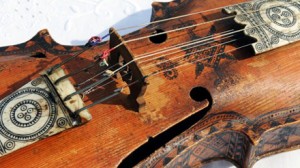
I hine hårde dager – da ved øldrikk og svir
hallingdølens knivblad – satt løst i hans slir,
da kvinnene til gilde – bar likskjorten med,
hvori de kunne legge – sin husbonde ned;
…stod der et bryllup – i Hemsedal etsteds…
In the hardened days of yore – when with beer and brawn
the knives of Hallingdal – from their sheaths were often drawn
when women to the feast – funeral shirts would bring
with which they would swathe – their dead husbands in
…there once took place a wedding – somewhere in Hemsedal…
A Hardanger fiddle (or in Norwegian: hardingfele) is a traditional stringed instrument used originally to play the music of Norway. In modern designs, the instruments are very similar to the violin, though with eight or nine strings (rather than four as on a standard violin) and thinner wood. Four of the strings are strung and played like a violin, while the rest, aptly named understrings or sympathetic strings, resonate under the influence of the other four, providing a pleasant haunting, echo-like sound. In many folktales the devil is associated with the Hardingfele, in fact many good players were said to have been taught to play by the devil himself. Fanitullen is the name of one of the most famous norwegian folktunes. It means «The Devil’s Tune», and according to legend, Fanitullen was conceived on a farm in Hol in the valley of Hallingdal in 1724 during a violent and bloody wedding. When one of the participants went to get more mead he saw the Devil himself sit on the barrel playing this tune on his fiddle.
During religious revivals in the 1800s many fiddles (regular and Hardanger) were destroyed or hidden both by fiddlers and laypeople who thought that it would be best for the soul that the fiddles be burned, as it was viewed as a sinful instrument that encouraged wild dances, drinking and fights.
The words for Fanitullen was written around 1850 by Jørgen Moe (1813-1882), a priest and an author. Jørgen Moe travelled across Norway with Peter Chr. Asbjørnsen in the 19th century, gathering Norwegian myths and fairy tales. Their tales of trolls, waterfall wizards (“Fossegrimen”) and wood nymphs (“Huldra”) are now a national treasure.Down he goes to tap beer – as the winner of the fight
may have need to kiss – the bowl’s rim tonight.
Within the belt they’ll duel, – blood running like sap
the vein will need refilling – from the beer casket tap.
Standing in the cellar – he saw a bluish glow
someone sitting on the casket – tuning fiddle, holding bow.
This man held it backwards – tightly to his chest
and as soon as it was tuned – put his fiddle to the test.
There came a song of wonder; – It rang like angry words,
Like steel bite into wood – Like fists rammed into boards.
It jubilantly roamed – Around the darkened cellar hall
And came to a halt – At the sound of a fall
Quietly the fiddler listened – to the mighty flow
It was like the music’s eddies – went down his spine and brow.
He quickly asked the other – “Where did you learn that song?”
The answer: “Don’t you mind that, – But remember it – for long!”
But as the man bent down – Reaching for the tap
He saw a horned hoof – against the casket rap.
He forgot to tap the beer – And ran up to the hall
Just as the men were lifting – The body from the fall
Fanitullen it is called – This wild and haunting spell
And in Hallingdale they play it – And they play it well
And when its tune is singing – to beer and feast and brawn
again knives of Hallingdale – from their sheaths are quickly drawn
From “Fanitullen”
Jørgen Moe (1813-1882)
(Translated to English by Espen Andersen, 2002)
External links:




